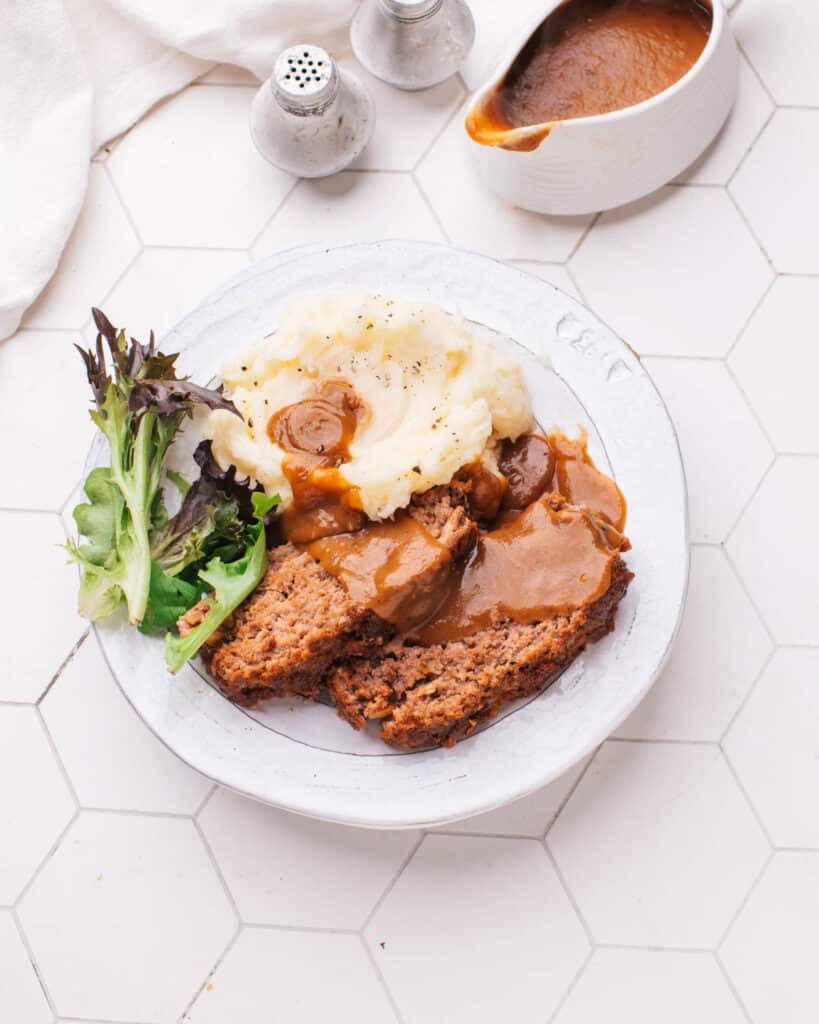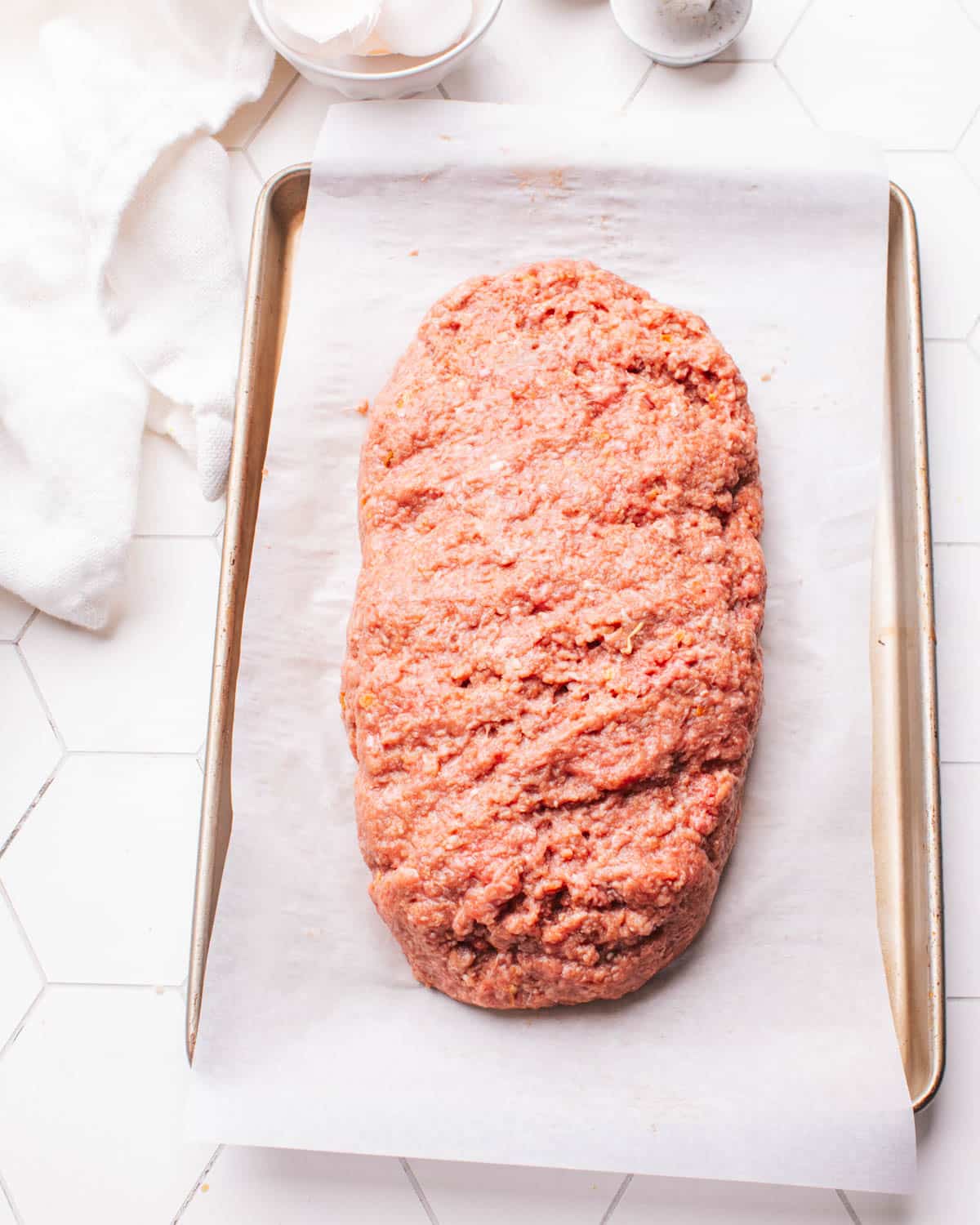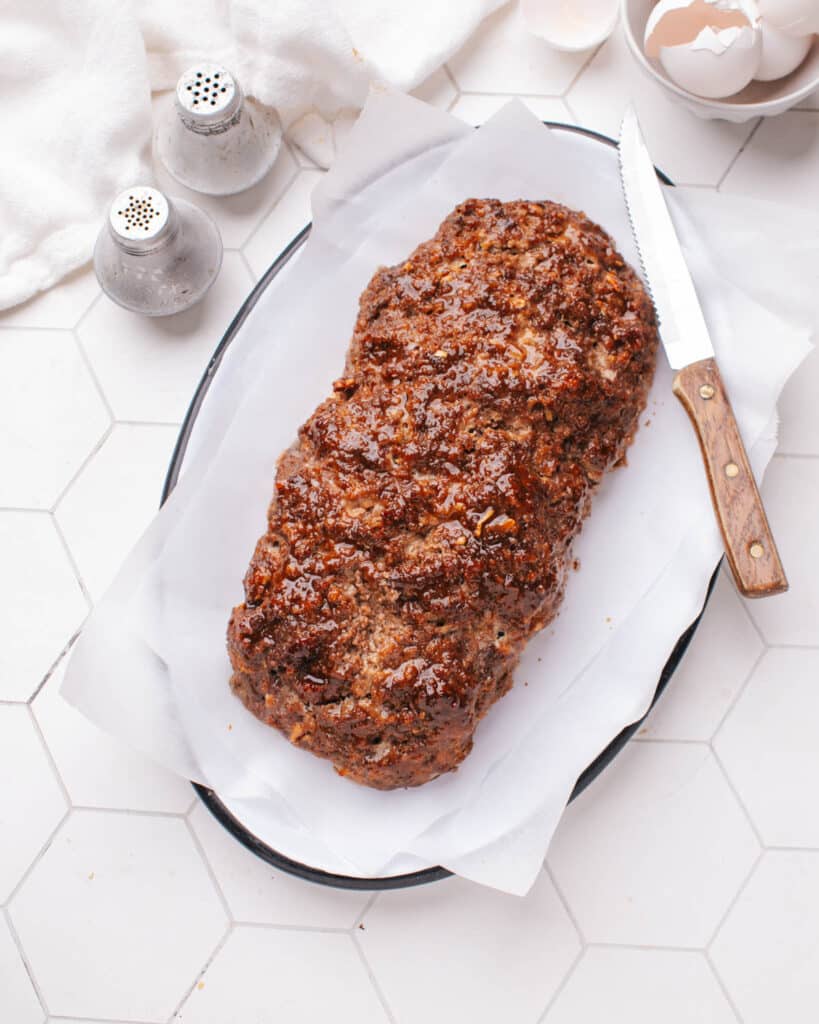Meatloaf Temp Guide (Key Cooking + Internal Temperatures to Know)
Nov 20, 2023, Updated Mar 08, 2024
From the best meatloaf cooking temperature to the internal temperature of meatloaf when done, here’s everything you need to know in a comprehensive Meatloaf Temp Guide!

I’m a food scientist, and I’m excited to share the key meatloaf temperatures you need to know for a perfectly-cooked, delicious dinner.
Getting the cooking and internal temp right can be the difference between a juicy, flavorful loaf and a dry disappointment. Let’s dive in!
Key Meatloaf Temp #1: Best Oven Temperature to Cook Meatloaf
The oven temperature you choose to bake your meatloaf plays a key role in the timing, texture, moisture content, and overall quality of your meatloaf.
Most recipes and experts suggest setting your oven between 350°F and 375°F, and here’s why each option matters.
Cooking at 350°F: Slow and Juicy Approach
When you opt for an oven temperature of 350°F, you’re embracing a “low and slow” cooking approach. This allows the fats and connective tissues in the meat to gradually break down, leaving you with a moist, flavorful loaf.
For a typical 2-lb meatloaf, it also ensures that the middle cooks through before the outside dries out.
The downside is that this temperature will require a longer cooking time, usually around 60 to 75 minutes for a standard-sized meatloaf. If you’re not in a rush and prefer a tender, juicy result, 350°F is your go-to temperature.

Cooking at 375°F: Quicker but Less Even
Setting the oven to 375°F can speed up the cooking process. You could be slicing into your meatloaf in as little as 45 minutes. Although quicker, cooking at this higher temperature has its downsides, primarily the risk of drying out the meatloaf.
Moisture Loss
The higher temperature can cause the proteins in the meat to contract more quickly, squeezing out moisture in the process.
Moisture loss is a concern in cooking meat at high temperatures for any length of time. When the meat cooks quickly at a high temperature, the cells and fibers can shrink rapidly, causing moisture to be lost forever.
Uneven Cooking
Cooking at a higher temperature also creates a temperature gradient where the outside gets much hotter than the inside, which can result in an unevenly cooked meatloaf. The outer layer of the meatloaf can dry out and even become overly browned or crusty before the middle reaches the desired internal temperature. This is especially true for larger or thicker meatloafs that require more time for the heat to penetrate to the center.
The 375ºF option is best reserved for smaller, thinner meatloaves made with 1 lb of meat, or little meatloaf muffins. Either of these won’t take as long to cook.
Key Meatloaf Temp #2: Internal Temp of Meatloaf When Done
The internal temperature of the meatloaf is a crucial indicator of its doneness, not only for safety, but for moist, juicy results.
The temperature to aim for depends on the ingredients of the meatloaf.
According to the USDA, the safe internal temperature for ground meat is 160 degrees f for meatloaf made with ground beef, ground pork, veal, and lamb, and 165°F for poultry (if you’re making a chicken or ground turkey meatloaf).
Use an instant-read thermometer to check the internal temperature. Insert the meat thermometer into the center of the meatloaf (or the thickest part) to ensure accuracy.
When meatloaf’s internal temperature reaches 160ºF, it’ll be cooked safely and still juicy.

Meatloaf Temp Tips for The Best Meatloaf Ever
– Preheating Is Essential
Don’t overlook the importance of preheating your oven. Placing meatloaf in an oven that hasn’t reached the desired temperature can result in uneven cooking. Make sure to preheat your oven to the specified temperature before putting in your meatloaf, as this will ensure a consistent cooking process.
– Don’t Skip Resting Time
Once your meatloaf has reached its safe internal temperature, it’s tempting to slice into it immediately for a taste.
However, letting it rest for about 10 minutes allows the juices to redistribute throughout the meat, making for a juicier, more flavorful, best meatloaf ever.
– Oven Variability and Hot Spots
It’s worth mentioning that all ovens are not created equal. Some may have hot spots or temperature fluctuations. To combat this, it’s advisable to rotate your meatloaf pan halfway through the cooking time to ensure even cooking. An oven thermometer can also be a useful tool to confirm that your oven is calibrated correctly.
– Fine-Tuning with Foil
If the outside of your meatloaf is browning too quickly while the inside is still undercooked, you can use aluminum foil to help. Simply place a piece of foil loosely over the top of the meatloaf.
The foil slows down the browning on top and helps keep the meatloaf moist. But don’t keep it covered the whole time, or you might end up with a soggy loaf. A good rule of thumb is to cook uncovered at first, then add foil as needed later on.
This foil trick lets you manage how your meatloaf cooks, so you get a moist, well-cooked dish every time.

Safely Storing and Reheating Leftover Meatloaf
Proper storage and reheating of leftover meatloaf are crucial to maintain its taste and ensure food safety. Here’s how to handle leftover meatloaf:
Storing Leftover Meatloaf
- Cooling Down: Allow the meatloaf to cool to room temperature before storing. However, don’t leave it out for more than 2 hours to avoid bacterial growth.
- Refrigeration: Wrap the meatloaf tightly in plastic wrap or aluminum foil, or place it in an airtight container. According to the USDA, if it was cooked properly to the recommended meatloaf temp of 160ºF for beef/pork, or 165ºF for poultry, and if it was refrigerated within 2 hours, it can be stored in the refrigerator for up to 3-4 days.
- Freezing: For longer storage, you can freeze meatloaf. Wrap it tightly in plastic wrap and then in foil, or place it in a freezer-safe container. Properly stored, it can last up to 3 months in the freezer.
Reheating Leftover Meatloaf
- Thawing: If frozen, thaw the meatloaf in the fridge overnight before reheating.
- Oven Reheating: Preheat your oven to 250ºF. Place the meatloaf in an oven-safe dish and add a small amount of water or broth to keep it moist. Cover with foil and heat until it reaches an internal temperature of 165ºF. This usually takes about 25-30 minutes, depending on the size of the portion.
- Microwave Reheating: For a quicker option, you can reheat meatloaf slices in the microwave. Cover them with a microwave-safe lid or wrap in microwave-safe plastic wrap to retain moisture. Heat on medium power, checking frequently, until the meatloaf temp reaches 165ºF internally.
Related: Delicious Leftover Meatloaf Recipes
Pro Tips and Meatloaf Temp Safety Tips
- Check Temperature Accurately: Use a food thermometer to ensure the reheated meatloaf reaches 165ºF. This temperature is considered safe by food safety authorities and will kill most bacteria.
- Avoid Multiple Reheatings: Try to reheat only the amount of meatloaf you plan to eat. Repeated reheating can compromise the texture and flavor, and increase the risk of foodborne illness.
- Moisture Retention: Adding a bit of broth or water when reheating can help to keep the meatloaf moist and prevent it from drying out.
By following these guidelines, you can safely enjoy your leftover meatloaf while still retaining its flavor and texture.

Best Meatloaf Recipes
- The Ultimate Meatloaf Recipe: There one that will turn you into a meatloaf lover. With a juicy, flavorful mixture of ground beef and pork, breadcrumbs, milk, eggs, and tasty add-ins, this classic meatloaf will satisfy all cozy cravings. You don’t even need a loaf pan, just a baking sheet and a skillet.
- Meatloaf Glaze: Try this simple 3-ingredient meatloaf glaze recipe with ketchup and worcestershire sauce. It tastes so good in meatloaf sandwiches the next day!
- Meatloaf with Brown Gravy: A juicy ground beef meatloaf drizzled with piping hot, rich brown gravy? YES PLEASE. Serve with the ultimate mashed potatoes and a green vegetable.
- Lipton Meatloaf Recipe: It’s got a cult following for good reason. A packet of onion soup mix replaces the onion, garlic and salt, and makes a perfectly-seasoned loaf in a fraction of the time. Just trust.
- The Turkey Meatloaf Recipe:that’ll turn you into a turkey meatloaf lover.
And don’t miss my collection of 31+ ideas for delicious meatloaf side dishes 0r 35+ of the best healthy sides to serve with meatloaf!











